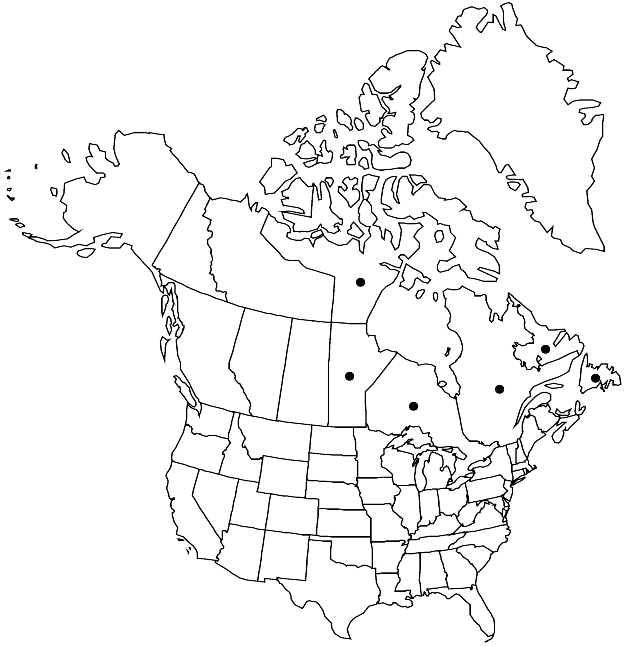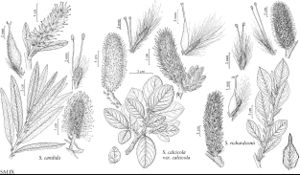Salix calcicola var. calcicola
Leaves: largest medial blade margins often purplish, teeth or glands 6–18 per cm, apex acuminate, acute, or rounded, adaxial surface dull. Pistillate flowers: adaxial nectary 0.6–1 mm; stipe 0.2–1.2 mm; ovary pyriform or obclavate; styles 1.6–3 mm; stigmas 0.2–0.38–0.56 mm. 2n = 38.
Phenology: Flowering early Jun-early Aug.
Habitat: Marine coastal shores, rubble above high tide, sand dunes, sandy and silty streamshores, clay frost boils, stony or gravelly calcareous substrates
Elevation: 0-300 m
Distribution

Man., Nfld. and Labr., Nunavut, Ont., Que.
Discussion
Hybrids:
Variety calcicola forms natural hybrids with Salix alaxensis var. alaxensis, S. candida, and S. richardsonii.
Variety calcicola × Salix candida (S. ×wiegandii Fernald): This hybrid is usually intermediate between its parents. It resembles S. candida in having leaves not marcescent, with crinkled leaf hairs and slightly glossy adaxial surfaces, and in flowering as leaves emerge. It resembles var. calcicola primarily in general leaf size and shape, in being sparsely to moderately densely hairy, in having its staminate catkins without a flowering branchlet, and floral bracts moderately to densely hairy. It differs from both parents in having ovaries with hairs in streaks or patches, a characteristic of many hybrids between species with glabrous and hairy ovaries. It is known only from the Northern Peninsula, Newfoundland, where it is common on coastal limestone barrens on tundra cliffs, growing on edges of pools and streams, and in sedge fens. Treated here as a hybrid, it could equally well be treated as a species of hybrid origin. The latter view is supported by its absence in northern Quebec, where the two parents also grow together.
Variety calcicola × Salix richardsonii: Polunin described S. richardsonii var. mckeandii (see 93. S. richardsonii for discussion) and S. calcicola var. nicholsiana, which he thought were hybridizing and intergrading on Baffin and Southampton islands, Nunavut. There is some suggestion of hybridization between S. calcicola and S. richardsonii on Southampton Island, but no clear evidence has been shown of hybridization elsewhere in Nunavut or Northwest Territories. At Churchill, Manitoba, where S. calcicola is common and S. richardsonii rare, specimens intermediate in leaf length, petiole length, and general leaf shape, and having stipules of S. richardsonii were recognized as putative hybrids, but hybrids between these species are uncommon.
Selected References
None.
